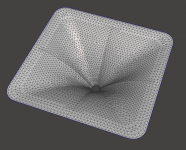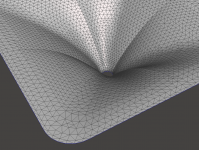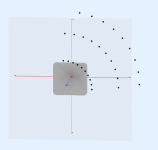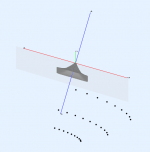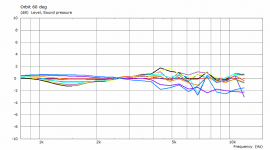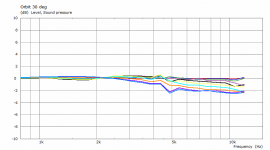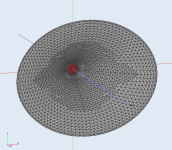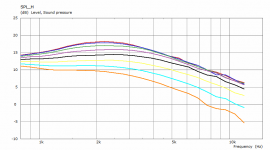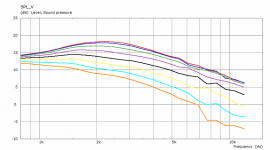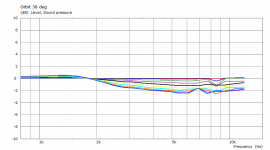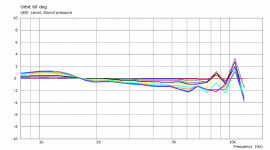I would be interested to see the configuration file you used if that is something you want to share, I understand if you don't 
In the first mesh images it looked a little like a vertical crease, nothing like the render with the offset swirl pattern, the triangles can confuse the eyes
In the first mesh images it looked a little like a vertical crease, nothing like the render with the offset swirl pattern, the triangles can confuse the eyes
My comments would be (in order)
* since loading is almost irrelevant to performance, I don't see this as very important.
* this is achievable now with a no-compromise design. Its the size and other details which when compromised create the performance degradation.
* since the acoustic nonlinearities in the waveguide are insignificant, this isn't very important.
* as the design becomes less diffraction oriented, the driver dominates the generation of HOMs. Hence, this is not really an aspect of the waveguide that is of concern. It is, of course, a big concern in waveguides where HOM generation is not taken into consideration, but for the "perfect" device we are talking about, the HOM generation in the waveguide is dwarfed by that generated by the driver.
I have couple technical remarks.
* Smoothness of acoustic load is important because it finally "turns" mechanical vibrations into the sound wave pressure (p(w)=v(w)*z(w)). So any irregularities/oscillations of acoustic load would inevitably affect the transient response. It is the fundamendal parameter we can't ignore in favour of directivity. Another question is to what extent irregularities of acoustic load are tolerable. Btw, Dr. Keith Holland was studied the subject in his PhD dissertation. And he pointed out, that reflection (= irregular acoustic load) is one of the key source of the "horn-like" sound".
* I partially agree on unimportance of horn-related related acoustic nonlinearities if we talk about relatively low SPL(i.e. typical for home audio), low compression ratio horns, and/or horns with very irregular acoustic load. Otherwise we can't ignore horn-produced acoustic nonlinearities. Although in my practice I was encountering quite strange behavior of nonlinearities in different horns. But perhaps horn-related nonlinearities is too specific problem to discuss in the mabat's topic
P.S. sorry mabat for perturbing your topic
So far I have only seen one (exotic) manufacturer, or rather his son, who seems to have taken this into account when developing custom driver / horn combinations. These are clearly modern revisions to Salmon horns and companion drivers, but an interview with the guy revealed that he extensively modeled, simulated and optimized the drivers (phase plugs) and horn interface(s) in COMSOL in order to suppress the modes.
I don't know or was in this topic discussed PhD thesis of Dr. Oclee Brown (KEF/Celestion), but if you interested in the problem of the phase plugs design I suggest to read it carefully. I suppose that at the moment this is the most detailed study on the subject.
I have couple technical remarks.
* Smoothness of acoustic load is important because it finally "turns" mechanical vibrations into the sound wave pressure (p(w)=v(w)*z(w)). So any irregularities/oscillations of acoustic load would inevitably affect the transient response. It is the fundamendal parameter we can't ignore in favour of directivity. Another question is to what extent irregularities of acoustic load are tolerable. Btw, Dr. Keith Holland was studied the subject in his PhD dissertation. And he pointed out, that reflection (= irregular acoustic load) is one of the key source of the "horn-like" sound".
I completely agree with Dr. Holland.
Hence you did catch me being partially incomplete in my statement. I thought that we had moved past horns with pronounced resonances, like diffraction horns, because there is simply no way to justify using such techniques when we know, to wit this thread, that exceptional performance can be obtained without such diffraction and the resulting resonances. Once this fact has been accepted then we can only really talk about "horns" that have the improved waveguides shown here. In that context, the "loading" is almost always very similar - no peaks and dips to worry about - totally unlike diffraction horns. Hence, it's not an important criteria within the designs being shown here.
* I partially agree on unimportance of horn-related related acoustic nonlinearities if we talk about relatively low SPL(i.e. typical for home audio), low compression ratio horns, and/or horns with very irregular acoustic load. Otherwise we can't ignore horn-produced acoustic nonlinearities. Although in my practice I was encountering quite strange behavior of nonlinearities in different horns. But perhaps horn-related nonlinearities is too specific problem to discuss in the mabat's topic.
Having taken "Nonlinear Acoustics" in school and knowing what I know, I can state categorically that nonlinearities in an acoustic horn/waveguide are irrelevant. You are thinking about the nonlinearities in the compression part of the "horn", which IMO, is not part of the horn/waveguide at all - It's fixed in the driver. That, and the driver motor itself, can be nonlinear, and will be large when compared to that of the waveguide. But still small enough so as to not be an audible factor in most situations.
Loading and transient response - don't get me started.
I don't know or was in this topic discussed PhD thesis of Dr. Oclee Brown (KEF/Celestion), but if you interested in the problem of the phase plugs design I suggest to read it carefully. I suppose that at the moment this is the most detailed study on the subject.
Yes, I have read that one as well. It's indeed one of the most comprehensive on the subject.
Having taken "Nonlinear Acoustics" in school and knowing what I know, I can state categorically that nonlinearities in an acoustic horn/waveguide are irrelevant. You are thinking about the nonlinearities in the compression part of the "horn", which IMO, is not part of the horn/waveguide at all - It's fixed in the driver. That, and the driver motor itself, can be nonlinear, and will be large when compared to that of the waveguide. But still small enough so as to not be an audible factor in most situations.
Horn and driver are 2 components of a single acoustic system.
"Phase plug is a mechanical interface placed between the compression driver diaphragm and the horn, it acts as an acoustic transformer equalizing sound wave path lengths and increasing radiation efficiency when the slots area is smaller than the diaphragm area (also
called Compression Ratio). Phase plug represents the first acoustic section of a horn driver that extends with horn flare shape. Horns have a cross sectional area which increases form a small throat at one end, to a large mouth at the other and acoustic pressure propagates from throat to mouth. The ideal electroacoustic efficiency is reached when acoustic impedance (phase plug and horn combination) is matched to the driver mechanical impedance (diaphragm and coil mass, mechanical resistance, suspension compliance, etc)."
Is it possible to eliminate nonlinearities alltogether?
Last edited:
Not at all! This thread is about designing horns after all. Only keep it easyP.S. sorry mabat for perturbing your topic.
You actually have good eyes. For the BEM, only the first quadrant (x >= 0, y >= 0) was used and repeated (mirrored), so the two are not the same and you are right. All the trick is to use the parameter "SF.Rot" (see this post) combined with "Shape = raw2rect". You would figure that out as well.I would be interested to see the configuration file you used if that is something you want to share, I understand if you don't
In the first mesh images it looked a little like a vertical crease, nothing like the render with the offset swirl pattern, the triangles can confuse the eyes
Last edited:
BTW, the actual mesh used can be exported from ABEC as STL (Options / Export mesh...) -
I doubt the vertical groove has any positive effect but the overall asymmetry induced by the rotated shaping curve seems to be a real advantage.
Working on a full-space mesh output for BEM. That will tell.
I doubt the vertical groove has any positive effect but the overall asymmetry induced by the rotated shaping curve seems to be a real advantage.
Working on a full-space mesh output for BEM. That will tell.
Attachments
Last edited:
Well that makes my eyes happy to know they weren't wrongYou actually have good eyes. For the BEM, only the first quadrant (x >= 0, y >= 0) was used and repeated (mirrored), so the two are not the same and you are right.
Is it possible to eliminate nonlinearities alltogether?
Of course it would be, but to what purpose?
I could design a system to have whatever level of nonlinearity that one wanted given the required SPL in some given size space. But that would make no sense.
Like Alex Voishvillo, Floyd Toole, Sean OLive and myself, we all believe that the perception of nonlinear distortion in audio is vastly overblown. Floyd Toole once told me that he covered nonlinear distortion in his book at the level it deserved - it was one paragraph in the entire book. That says a lot.
In all my investigations of perception I have found that nonlinear distortion does not even show up on a list of what is important. And yet, this error persists in the wide dogma that one hears about distortion.
So yes, it can be controlled, and it has been controlled to a level at which it is no longer a fundamental aspect of the audio experience.
Of course one can always create situations where the above is not the case, but one can also always create designs for which the above is clearly true. I prefer to do the later.
The idea that ever lowering of THD makes for better sound quality is simply false. No data supports this position.
Last edited:
And this is for the rectangular waveguide presented before.
Unfortunately I can't figure out how to pass curve labels to VACS. Anyway, these two plots are for 30° a 60° off-axis at 2 m, 10° step, normalized. Need higher resolution.
Maybe a "balloon" plot would be even better. I have to figure out how to do that.
Unfortunately I can't figure out how to pass curve labels to VACS. Anyway, these two plots are for 30° a 60° off-axis at 2 m, 10° step, normalized. Need higher resolution.
Maybe a "balloon" plot would be even better. I have to figure out how to do that.
Attachments
Last edited:
Is it possible to eliminate nonlinearities alltogether?
the only honest answer to that is no, everything else is meta talk and conjecture.
Shape Optimization of a Compression Driver Phase Plug, Bernland et al. (2019).
Attached: a recent patent on phase plug assembly.
@ Dr. Geddes, thank you for your reply.
Attached: a recent patent on phase plug assembly.
@ Dr. Geddes, thank you for your reply.
Attachments
Last edited:
I've heard stories about subharmonics in compression drivers, how awful they can be. Are you familiar with any study of audibility of this phenomenon? I wonder how to measure and judge on the quality of a particular CD in this regard.
I studied sub-harmonics a bit. I talked with a leading authority on nonlinear systems theory (Prof. Schetzen) and he informed me that sub-harmonics cannot be generated by a time-invariant system, even a nonlinear one. He said that for sub-harmonics to be generated the system must be time-variant.
Hence for sub-harmonics to be generated, something must be changing in time. Things like temperature, or physical configuration, etc.
I have never seen sub-harmonics in a CD, but I have seen them in direct radiators. This can happen with a weak cone, one that flexes and creates an "oil-can" type of mode, where on one cycle the shape goes one way and on the other it goes the other way. This can happen and maybe this is also what happens in a CD that exhibits this behavior. It would likely be very audible since it generates tones that are never present in the signal, unlike most harmonics, which are.
Being so rare, it is hardly ever looked at.
Shape Optimization of a Compression Driver Phase Plug, Bernland et al. (2019).
@ Dr. Geddes, thank you for your reply.
Your welcome.
That disertation seems to have missed my patents on phase plug design, that's disappointing since there is a lot of good info in those patents, including a critical analysis of Smith's work. As a Professor I am very passionate about literature searches. When good material is missed, you have to wonder how much else was missed.
- Home
- Loudspeakers
- Multi-Way
- Acoustic Horn Design – The Easy Way (Ath4)
